Themed collection In Celebration of Andrew D. Hamilton’s Career in Chemistry

In celebration of the 60th birthday of Professor Andrew D. Hamilton FRS
An on-line collection of articles celebrating the 60th birthday of Professor Andrew D. Hamilton FRS has been published featuring contributions from students and colleagues past and present.

Org. Biomol. Chem., 2013,11, 6236-6241
https://doi.org/10.1039/C3OB90109B
Chemical approaches for detection and destruction of nerve agents
Since the introduction of organophosphorus (OP) compounds as nerve agents and pesticides, methods of dealing with their toxicity to humans have been intensely researched.

Org. Biomol. Chem., 2013,11, 3936-3942
https://doi.org/10.1039/C3OB40324F
AApeptides as a new class of antimicrobial agents
Herein we describe the development of AApeptides as a new class of peptidomimetics that mimic natural antimicrobial peptides.
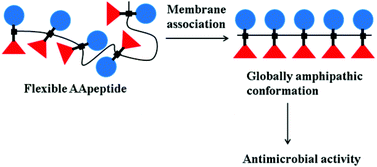
Org. Biomol. Chem., 2013,11, 4283-4290
https://doi.org/10.1039/C3OB40444G
Changes in lipid density induce membrane curvature
Highly curved bilayer lipid membranes make up the shell of many intra- and extracellular compartments, including organelles and vesicles. Using all-atom molecular dynamics simulations, we show that increasing the density of lipids in the bilayer membrane can induce the membrane to form a curved shape.
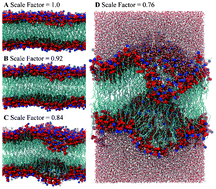
RSC Adv., 2013,3, 13622-13625
https://doi.org/10.1039/C3RA42332H
Influence of achiral units with gem-dimethyl substituents on the helical character of aliphatic oligourea foldamers
The structures of various urea oligomers incorporating one or two central achiral 1,2-diamino-1,1-dimethylethane (DADME) units have been investigated in solution and in the crystalline state.
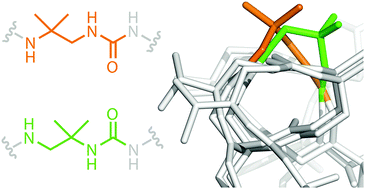
Chem. Commun., 2013,49, 7415-7417
https://doi.org/10.1039/C3CC40961A
Storable palladacycles for selective functionalization of alkyne-containing proteins
We report facile preparation of palladacycles as storable arylpalladium(II) reagents from acetanilides via cyclopalladation. The palladacycles exhibited good stability in PBS buffer and were capable of functionalizing a metabolically encoded HPG-containing protein, thus providing a new type of biocompatible organometallic reagent for selectively functionalizing the alkyne-encoded proteins.

Chem. Commun., 2013,49, 6809-6811
https://doi.org/10.1039/C3CC43479F
Diverse topologies in dynamic combinatorial libraries from tri- and mono-thiols in water : sensitivity to weak supramolecular interactions
We describe here the use of disulfide exchange reactions to generate distinct supramolecular topologies within a dynamic combinatorial library (DCL) derived from tri- and mono-functionalised thiol components in water.
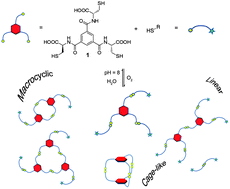
Chem. Commun., 2013,49, 5820-5822
https://doi.org/10.1039/C3CC41158C
Antimicrobial N-(2-chlorobenzyl)-substituted hydroxamate is an inhibitor of 1-deoxy-D-xylulose 5-phosphate synthase
A simple hydroxamate, derived from hydrolysis of ketoclomazone, was found to inhibit Haemophilus influenzae 1-deoxy-D-xylulose 5-phosphate synthase at the low μM range and suppress bacterial growth.
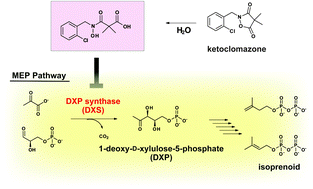
Chem. Commun., 2013,49, 5535-5537
https://doi.org/10.1039/C3CC40758F
Towards a dynamic covalent molecular switch: substituent effects in chalcone /flavanone isomerism
Chalcone/flavanone interconversion occurs facilely under aqueous alkaline conditions making it a promising scaffold for the development of a covalent molecular switch.

Org. Biomol. Chem., 2013,11, 3421-3423
https://doi.org/10.1039/C3OB40467F
A foldamer approach to targeting membrane bound helical states of islet amyloid polypeptide
A small molecule, protein mimetic based approach is shown to specifically inhibit lipid catalysed self-assembly of islet amyloid polypeptide (IAPP).
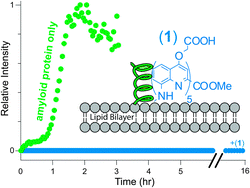
Chem. Commun., 2013,49, 4749-4751
https://doi.org/10.1039/C3CC41452C
Controllable self-assembly of amphiphilic macrocycles into closed-shell and open-shell vesicles, nanotubes , and fibers
Two structurally similar amphiphilic macrocycles differing in functional groups self-assemble into closed-shell and open-shell vesicles in polar solvents and morph into nanotubes and fibers upon acidification.
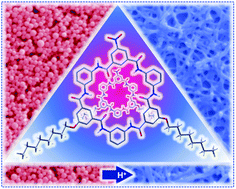
Chem. Commun., 2013,49, 4601-4603
https://doi.org/10.1039/C3CC40535D
Synthesis of peptoid based small molecular gelators by a multiple component reaction
Novel tripeptoid gelators are synthesized by a one-pot Ugi reaction from simple starting materials.
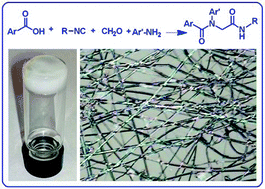
Chem. Commun., 2013,49, 4489-4491
https://doi.org/10.1039/C3CC41043A
Quantitative detection of single base mutation by combining PNA hybridization and MALDI-TOF mass analysis
Peptide nucleic acid (PNA) probes were designed to bind to the internal reference sequence and the single base mutation sequence within PCR-amplified DNA templates, and the PNA probes were quantitatively analyzed with MALDI-TOF mass spectrometry.
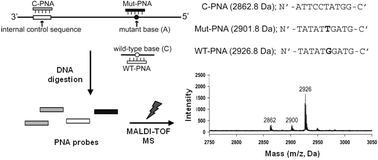
Chem. Commun., 2013,49, 3754-3756
https://doi.org/10.1039/C3CC00070B
Complete shift of ferritin oligomerization toward nanocage assembly via engineered protein –protein interactions
A straight-forward computational method is used to redesign protein–protein interfaces of a dimorphic nanocage forcing it to assemble with monomorphism.
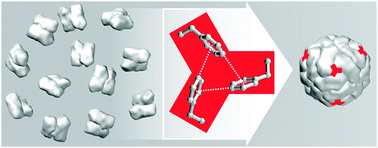
Chem. Commun., 2013,49, 3528-3530
https://doi.org/10.1039/C3CC40886H
Monitoring the HIV-1 integrase enzymatic activity using atomic force microscopy in a 2LTR system
Partial and full integration products were observed using AFM in a 2LTR system.

Chem. Commun., 2013,49, 3113-3115
https://doi.org/10.1039/C3CC40748A
Resonance-assisted hydrogen bonding induced nucleophilic addition to hamper ESIPT: ratiometric detection of cyanide in aqueous media
For ratiometric “naked eye” detection of CN−, an ESIPT exhibiting benzothiazole receptor (BHI) is designed having one aldehyde group ortho and the other aldehyde para to the OH group respectively.
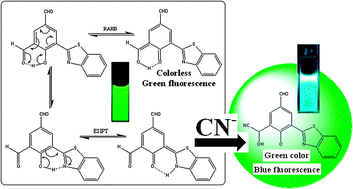
Chem. Commun., 2013,49, 2912-2914
https://doi.org/10.1039/C3CC39256B
Novel pH responsive calix[8]arene hydrogelators: self-organization processes at a nanometric scale
Water soluble amphiphilic calix[8]arenes form pH-responsive and reversible supramolecular hydrogels; depending on their functionalization, pH variations trigger hydrogelation under basic or acidic conditions.
![Graphical abstract: Novel pH responsive calix[8]arene hydrogelators: self-organization processes at a nanometric scale](/en/Image/Get?imageInfo.ImageType=GA&imageInfo.ImageIdentifier.ManuscriptID=C3CC40374B&imageInfo.ImageIdentifier.Year=2013)
Chem. Commun., 2013,49, 2530-2532
https://doi.org/10.1039/C3CC40374B
Supramolecular hydrogels based on bola-amphiphilic glycolipids showing color change in response to glycosidases
This communication describes supramolecular hydrogels exhibiting color change in response to glycosidases, which was successfully employed to construct a colorimetric sensor array chip for rapid detection of glycosidases.
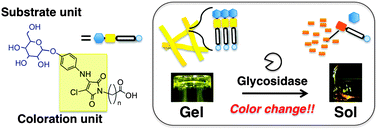
Chem. Commun., 2013,49, 2115-2117
https://doi.org/10.1039/C2CC37908B
1,3,5-Trisubstituted benzenes as fluorescent photoaffinity probes for human carbonic anhydrase II capture
The synthesis of small molecule based 1,3,5-trisubstituted benzenes for photo-mediated capture of human carbonic anhydrase II with visualisation by fluorescence is described.

Chem. Commun., 2013,49, 1930-1932
https://doi.org/10.1039/C3CC38251F
Major mechanistic differences between the reactions of hydroxylamine with phosphate di- and tri-esters
Hydroxylamine reacts with the diester anion DPP− by the expected concerted SN2(P) mechanism, but with the triester TPP by an addition–elimination process, with breakdown of the phosphorane intermediate rate-determining.

Org. Biomol. Chem., 2013,11, 6272-6284
https://doi.org/10.1039/C3OB40988K
Discovery of N-(4-sulfamoylphenyl)thioureas as Trypanosoma brucei leucyl-tRNA synthetase inhibitors
We report the discovery of N-(4-sulfamoylphenyl)thioureas as a new class of T. brucei LeuRS inhibitors.
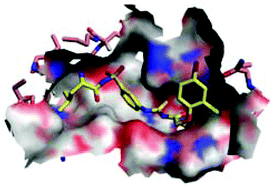
Org. Biomol. Chem., 2013,11, 5310-5324
https://doi.org/10.1039/C3OB40236C
Synthesis and biological activity of phosphoglycolipids from Thermus thermophilus
Unique glycolipids from an extreme thermophile, Thermus thermophilus, were synthesized for the first time, with newly developed glycosylation methods.
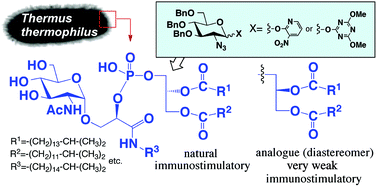
Org. Biomol. Chem., 2013,11, 5034-5041
https://doi.org/10.1039/C3OB40899J
New meso-substituted trans-A2B2 di(4-pyridyl)porphyrins as building blocks for metal-mediated self-assembling of 4 + 4 Re(I)–porphyrin metallacycles
An optimized high-yield synthesis of meso-arylsubstituted trans-A2B2 di(4-pyridyl)porphyrins and their use as building blocks in the Re(I)-mediated self-assembling of square metallacycles are presented.
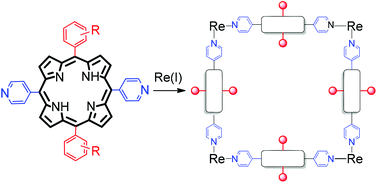
Org. Biomol. Chem., 2013,11, 4056-4067
https://doi.org/10.1039/C3OB40452H
An efficient chemical synthesis of carboxylate-isostere analogs of daptomycin
Herein we report a direct and efficient method for the synthesis of four new carboxylate-isostere analogs of daptomycin.
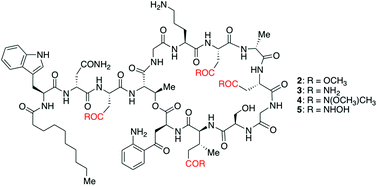
Org. Biomol. Chem., 2013,11, 4680-4685
https://doi.org/10.1039/C3OB40924D
Meta-analysis in asymmetric catalysis. Influence of chelate geometry on the roles of PN chelating ligands
Analysis of X-ray crystal structures for families of PN ligands reveal conformational variations that can be linked to trends in catalytic asymmetric synthesis.

Org. Biomol. Chem., 2013,11, 4591-4601
https://doi.org/10.1039/C3OB40360B
Structural modifications of (Z)-3-(2-aminoethyl)-5-(4-ethoxybenzylidene)thiazolidine-2,4-dione that improve selectivity for inhibiting the proliferation of melanoma cells containing active ERK signaling
Cell-based SAR of an ERK docking domain inhibitor
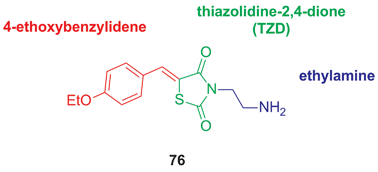
Org. Biomol. Chem., 2013,11, 3706-3732
https://doi.org/10.1039/C3OB40199E
Four-component assembly in the crystalline state driven by amidinium–carboxylate salt bridge formation from an aqueous solution
The introduction of two amidinium groups to the 1,8-position of a spacer unit can control the direction of formation of a self-assembled structure and succeeded in the formation of a four-component assembled structure .

Org. Biomol. Chem., 2013,11, 3692-3698
https://doi.org/10.1039/C3OB40309B
One-shot preparation of an inherently chiral trifunctional calix[4]arene from an easily available cone-triformylcalix[4]arene
An inherently chiral ABCH-substituted cone-calix[4]arene derivative has been prepared in a one-step process starting from the easily available cone-triformylcalix[4]arene.
![Graphical abstract: One-shot preparation of an inherently chiral trifunctional calix[4]arene from an easily available cone-triformylcalix[4]arene](/en/Image/Get?imageInfo.ImageType=GA&imageInfo.ImageIdentifier.ManuscriptID=C3OB40355F&imageInfo.ImageIdentifier.Year=2013)
Org. Biomol. Chem., 2013,11, 3642-3648
https://doi.org/10.1039/C3OB40355F
Peptide inhibitors of the Keap1–Nrf2 protein –protein interaction with improved binding and cellular activity
We describe potent peptide conjugate inhibitors of the Keap1–Nrf2 protein–protein interaction that have activity in cell based Nrf2 induction assays.
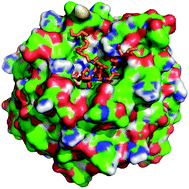
Org. Biomol. Chem., 2013,11, 3553-3557
https://doi.org/10.1039/C3OB40249E
Silanization of quartz , silicon and mica surfaces with light-driven molecular motors: construction of surface-bound photo-active nanolayers
The attachment of molecular rotary motors containing triethoxysilane functional groups to quartz, silicon and mica surfaces is described and the effect of photochemical and thermal isomerization steps on the surface assemblies was studied.

Org. Biomol. Chem., 2013,11, 3477-3483
https://doi.org/10.1039/C3OB40276B
Subtle “supramolecular buttressing effects” in Cucurbit[7]uril/guest assemblies
“Supramolecular buttressing” was defined as the alteration, by a neighboring unit, of a substituent effect on intermolecular recognition, and was assessed using Cucurbit[7]uril–guest assemblies.
![Graphical abstract: Subtle “supramolecular buttressing effects” in Cucurbit[7]uril/guest assemblies](/en/Image/Get?imageInfo.ImageType=GA&imageInfo.ImageIdentifier.ManuscriptID=C3OB40250A&imageInfo.ImageIdentifier.Year=2013)
Org. Biomol. Chem., 2013,11, 3116-3127
https://doi.org/10.1039/C3OB40250A
Polyhydroxylated pyrrolizidine alkaloids from transannular iodoaminations: application to the asymmetric syntheses of (−)-hyacinthacine A1, (−)-7a-epi-hyacinthacine A1, (−)-hyacinthacine A2, and (−)-1-epi-alexine
Transannular iodoamination of substituted 1,2,3,4,7,8-hexahydroazocines facilitates the asymmetric synthesis of polyhydroxylated pyrrolizidine alkaloids.
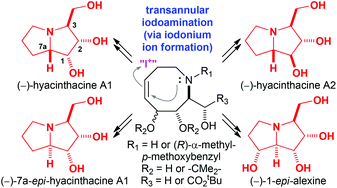
Org. Biomol. Chem., 2013,11, 3187-3202
https://doi.org/10.1039/C3OB40205C
Reaction-based dual signaling of fluoride ions by resorufin sulfonates
Resorufin nosylate exhibited naked-eye detectable colorimetric and fluorogenic signaling of fluoride ions in acetonitrile. The interference from sulfide ions was effectively suppressed by using the TPEN–Cu2+ complex as a masking agent.

Org. Biomol. Chem., 2013,11, 2966-2971
https://doi.org/10.1039/C3OB00040K
Dual signaling of hydrazine by selective deprotection of dichlorofluorescein and resorufin acetates
Highly selective chemosignaling behaviors toward hydrazine of a reaction-based probe of dichlorofluorescein and resorufin acetates were investigated. Hydrazinolysis of latent dichlorofluorescein and resorufin acetates revealed prominent chromogenic and fluorogenic signaling.
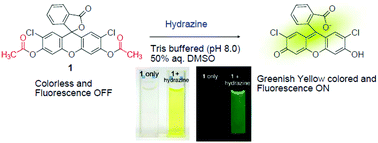
Org. Biomol. Chem., 2013,11, 2961-2965
https://doi.org/10.1039/C3OB40091C
Sequential enantiodivergent organocatalysis: reversibility in enantioswitching controlled by a conformationally flexible guanidine /bisthiourea organocatalyst
Here we describe our studies on solvent-dependent enantiodivergent Mannich-type reactions utilizing conformationally flexible guanidine/bisthiourea organocatalyst (S,S)-1.
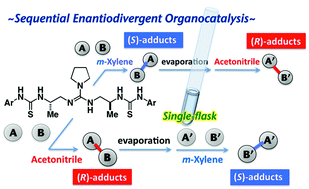
Org. Biomol. Chem., 2013,11, 2780-2786
https://doi.org/10.1039/C3OB27479A
Protein destabilisation by ruthenium(II) tris-bipyridine based protein-surface mimetics
A ruthenium(II) tris-chelate perturbs the folding landscape of its target protein leading to lowered melting temperatures and accelerated proteolysis.

Org. Biomol. Chem., 2013,11, 2206-2212
https://doi.org/10.1039/C3OB26251K
A rotaxane host system containing integrated triazole C–H hydrogen bond donors for anion recognition
A novel bis-triazole pyridinium axle containing rotaxane, prepared by a chloride anion templated ring closing metathesis clipping strategy, exhibits selectivity for halide anions over oxoanions with a notable preference for bromide being shown amongst the halides.
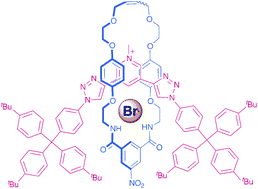
Org. Biomol. Chem., 2013,11, 1326-1333
https://doi.org/10.1039/C2OB27229F
About this collection
We are delighted to present this collection of articles that have been dedicated to Professor Andrew D. Hamilton FRS, on the occasion of his 60th birthday. Featuring contributions from students and colleagues past and present, and an introductory Profile article by guest-editors Sam Thompson and Andrew J. Wilson, with the contribution of Sir Alan R. Battersby.
We hope you enjoy the collection!